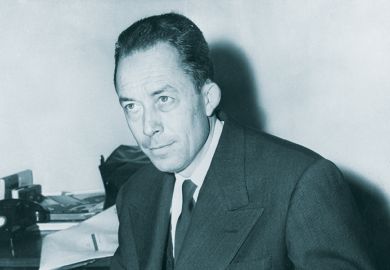Shakespeare was a thinker who did his thinking in dramatic dialogue." That is the motto-statement of Frank Kermode's long-awaited Shakespeare's Language . He redresses what is certainly a defect of current commentary, its lack of interest in Shakespeare's words. "Every other aspect of Shakespeare is studied almost to death, but the fact that he was a poet has somehow dropped out of consideration." In his disengagement from the preoccupations of contemporary scholarship, Kermode returns to the fundamental substance of the plays.
Shakespeare's Language rests on the tripod of text, OED , concordance. Everything depends on the words, as canvassed between folio and quarto; the meanings, as assembled in lexical ranks; the numbers, as conveyed in Spevack. Kermode is especially alert to number signals, for example when discussing the 17 instances of the apparently unremarkable "become" in Antony and Cleopatra ("a semantic subplot"). He understands a central truth of Shakespeare, that his vocabulary is rich not only in new words, but the same words used in different senses. The Merchant of Venice is "a text always impregnated with ideas, and with words that are always under question from the language itself of the play". That is the grand tendency of Shakespeare's mature work: he moves on from making prose "the language of criticism" (of As You Like It ) to making the words conduct their own critique. Kermode sees "The Phoenix and Turtle" as pivotal, a poem that "offers a paradigm of Shakespeare's obsession with the idea of two-in-one". It is a short step to Hamlet , whose language is "obsessed with doubles", and there is a masterly demonstration that Hamlet's way of speaking is "duplicative". The key Shakespeare device is hendiadys ("The perfume and suppliance of a minute"). Kermode views the meaning of hendiadys as "a kind of unnaturalness in the doubling, a sort of pathological intensification of the device". It is rampant in Hamlet , the linguistic symptom of the unresolved tensions at the play's heart. Hendiadys is a recurring concern, a rhetorical scheme that Stephen Greenblatt thought of as a Shakespearean "fingerprint". Shakespeare's language calls on a critic to develop his own metaphors, and Kermode supplies them with a fluent mastery. Certain words and themes in Macbeth - "time", "man", "blood", "dark" - are the "matrices" of the play. In the great tragedies "these matrices appear to have been fundamental to Shakespeare's procedures". At other times, the verse is merely "cruising". The presence of clowns forces the tragic heroes or heroines "to get down from their stilts". Such terms are the polar opposite of jargon: they are unpretentious, illuminating, the expressions of a writer at ease with his subject.
One side of Shakespeare's language is an impatient will to wrest new meanings from word forms. "In Coriolanus we have this lexical and syntactic habit in its full maturity: stubborn repetition, free association, violent ellipses; in short, a prevailing ruggedness of tone." The other side is a growing lack of simple clarity. "Even when the point seems simple, there is often a kind of aura of obscurity, enough strain on the language to tax the reader's mind." The simplest of formulations may leave an unexplored hinterland of meaning. With all his soliloquies and all those sessions on the psychiatrist's couch, Hamlet is still holding back.
Some cavils. The discussion of folio "cuts" in King Lear falls into an ontological trap, that of regarding "cut" as purposive. "Cut" might be mere subsidence, or a decision taken by others than Shakespeare. Stage directors never let go of the mock trial, "cut" in the folio. On Measure for Measure , Kermode gives a fine, post-Empsonian analysis of the first half, then dismisses the second half as a "muddle". This is to miss the play's movement from darkness to light, from repressed sexuality to open accommodation. "'Motion' is a rich way of talking about the human body", but one has to follow it from "wanton stings and motions of the sense" to the final "Dear Isabel,/ I have a motion much imports your good." The graph line extends from low left (sensual urges) to top right (quasi-legal,formal proposal of marriage). The Euclidean logic of Shakespeare's endings really needs more treatment.
Again, "Language in the service of characterisation", but Kermode is unwilling to consider the theatrical dimension. In Pericles , Marina "is accused of speaking 'holy words to the Lord Lysimachus', in this context a shocking, almost blasphemous thing to do". Not at all: it is funny. Boult, the brothel doorman, has the social conservatism of his class: he is outraged that this teenage evangelist should preach at a valued client from the peerage. Language is inhabited by actors. The words are also stage directions. They do not do it on their own.
Kermode has chosen his book's limitations, however, and his engagements with language are brilliant and fruitful. This book is essential for specialists, as well as the general readership at which it is aimed. Shakespeare's Language is easily the most distinguished recent addition to a line going back two centuries, to Whiter's A Specimen of a Commentary on Shakespeare .
Ralph Berry is the author of Tragic Instance: The Sequence of Shakespeare's Tragedies .
Shakespeare's Language
Author - Frank Kermode
ISBN - 0 71 399378 2
Publisher - Allen Lane The Penguin Press
Price - £20. 00
Pages - 320
Register to continue
Why register?
- Registration is free and only takes a moment
- Once registered, you can read 3 articles a month
- Sign up for our newsletter
Subscribe
Or subscribe for unlimited access to:
- Unlimited access to news, views, insights & reviews
- Digital editions
- Digital access to THE’s university and college rankings analysis
Already registered or a current subscriber? Login



